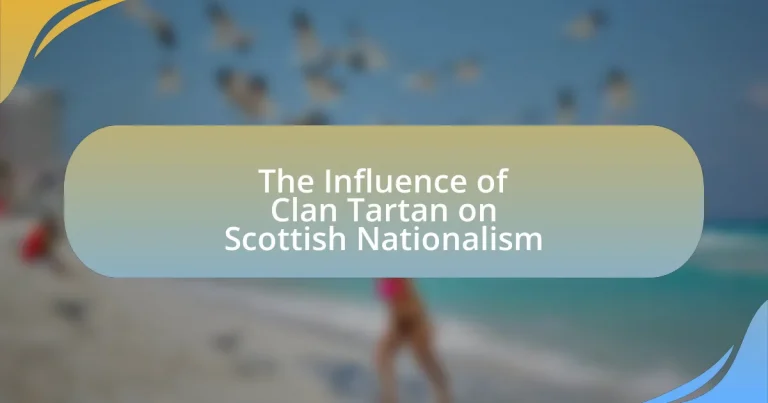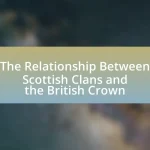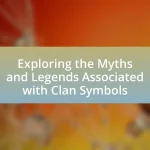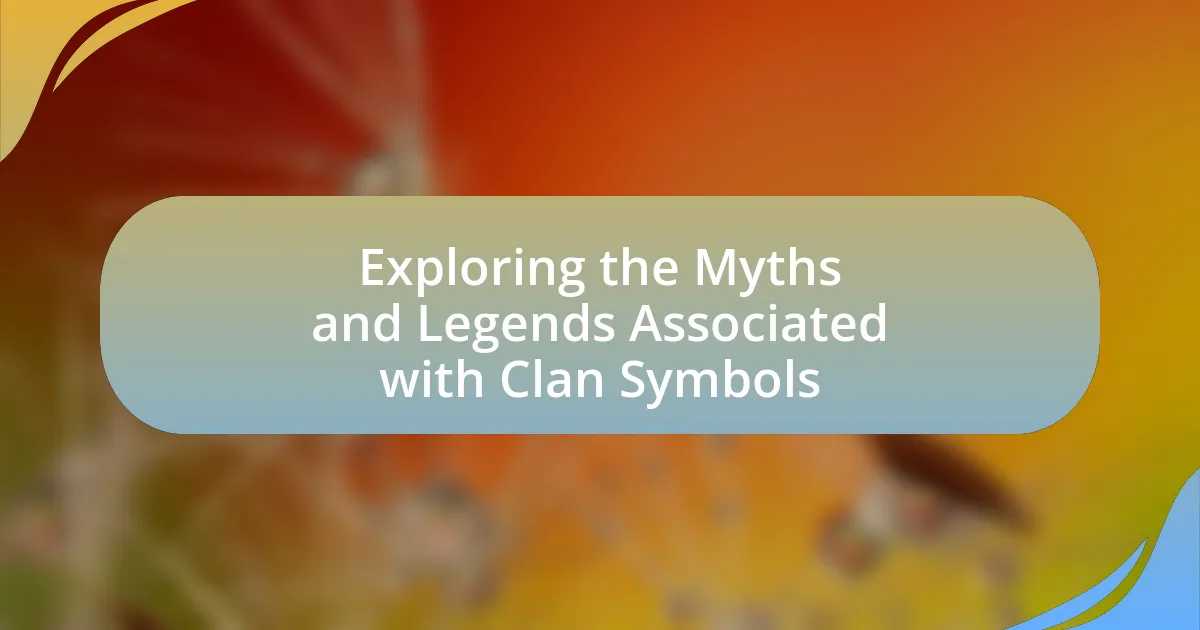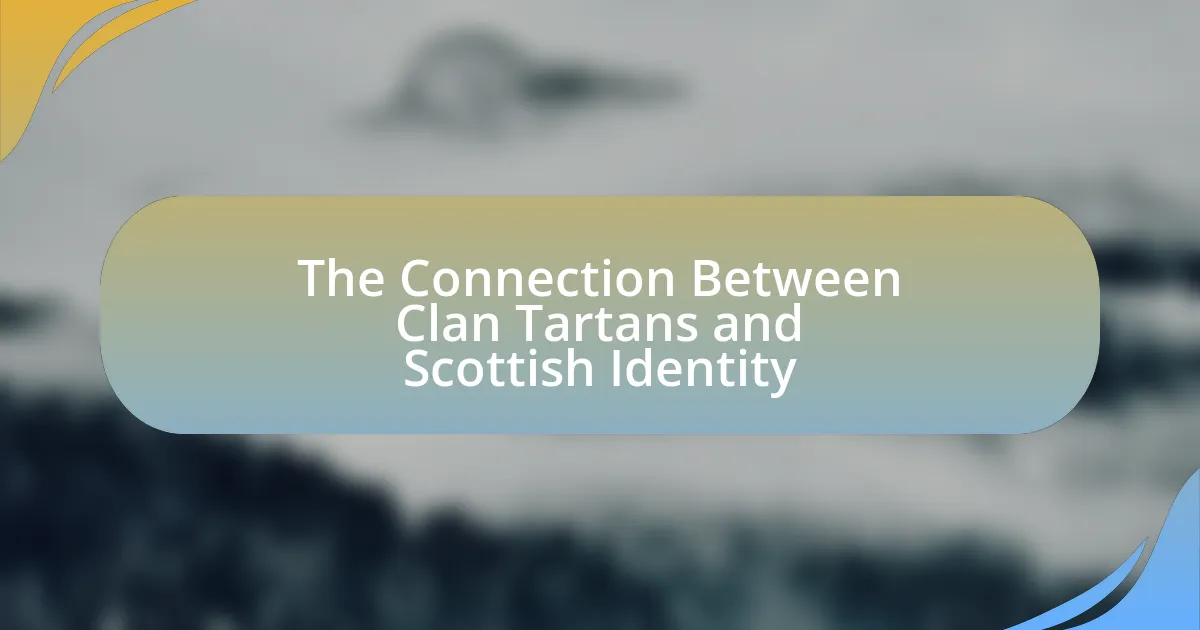Clan tartan plays a crucial role in Scottish nationalism by symbolizing cultural identity and heritage, fostering a sense of belonging among Scots. The article explores the origins and evolution of clan tartans, highlighting their historical significance, particularly during the Jacobite uprisings and the Romantic movement of the 19th century. It examines how tartans have been used in contemporary political movements, cultural expressions, and events, reinforcing national pride and unity. Additionally, the article discusses the emotional connections individuals have with their clan tartans and their impact on Scotland’s global image and diaspora.

What is the Influence of Clan Tartan on Scottish Nationalism?
Clan tartan significantly influences Scottish nationalism by serving as a symbol of cultural identity and heritage. The distinct patterns associated with various clans foster a sense of belonging and pride among Scots, reinforcing their connection to historical narratives and traditions. For instance, during the 19th century, the revival of interest in clan tartans coincided with the rise of the Scottish nationalist movement, as these patterns became emblematic of Scotland’s unique cultural landscape. This connection is evident in events like the Highland Games and the use of tartan in national celebrations, which promote unity and a shared Scottish identity. The adoption of tartan by various organizations and political movements further solidifies its role in expressing national pride and advocating for Scotland’s autonomy.
How did clan tartans originate and evolve in Scotland?
Clan tartans originated in Scotland as distinct patterns associated with specific clans, primarily during the 16th century. Initially, these patterns were created using locally sourced dyes and materials, reflecting the natural environment of the region. Over time, the use of tartan became more formalized, particularly after the 1745 Jacobite uprising, when tartans were adopted as symbols of clan identity and Scottish nationalism. The 19th century saw a significant evolution in tartan design, with the establishment of the Highland Society of London in 1778 and the subsequent publication of tartan registries, which standardized patterns and colors. This formalization contributed to the widespread recognition of clan tartans as emblems of Scottish heritage and pride.
What historical events contributed to the development of clan tartans?
The development of clan tartans was significantly influenced by historical events such as the Jacobite uprisings of the 18th century and the subsequent Acts of Proscription. The Jacobite uprisings, particularly those in 1715 and 1745, aimed to restore the Stuart monarchy and fostered a sense of Scottish identity, leading to the popularization of tartans as symbols of clan allegiance. Following the defeat at the Battle of Culloden in 1746, the British government enacted the Dress Act, which prohibited the wearing of tartan and other Highland dress, inadvertently solidifying tartan’s association with Scottish nationalism. This ban led to a resurgence of interest in tartans as symbols of resistance and cultural pride, culminating in their revival in the 19th century during the Romantic movement, which celebrated Scottish heritage.
How did the use of tartans change over time among Scottish clans?
The use of tartans among Scottish clans evolved significantly from the 16th century to the present day. Initially, tartans were primarily practical, serving as a form of camouflage for clansmen in the Highlands, with patterns varying based on local resources and weaving techniques. By the 19th century, the romanticization of Scottish culture led to the formalization of tartan patterns, with specific designs being associated with particular clans, as seen in the establishment of the Highland Society of London in 1778, which promoted clan tartans. This shift was further solidified by Queen Victoria’s interest in Scottish heritage, which popularized tartans as symbols of clan identity and national pride. Today, tartans are widely recognized as emblems of Scottish nationalism, representing both heritage and cultural unity, as evidenced by their use in modern Scottish events and celebrations.
Why are clan tartans significant to Scottish identity?
Clan tartans are significant to Scottish identity because they symbolize heritage, unity, and belonging among Scottish clans. Each tartan pattern is uniquely associated with a specific clan, representing its history, values, and traditions. The use of tartans became prominent in the 18th century, particularly after the Jacobite uprisings, when they were adopted as a symbol of Scottish nationalism and resistance against English rule. This cultural significance was further solidified by the 1822 visit of King George IV to Scotland, where the display of tartans was encouraged, leading to their widespread acceptance as a national emblem. Thus, clan tartans serve as a visual representation of Scottish identity, fostering a sense of pride and connection to ancestral roots.
What role do clan tartans play in cultural expressions of Scottish nationalism?
Clan tartans serve as a significant symbol of cultural identity and pride within Scottish nationalism. These distinctive patterns, associated with specific clans, foster a sense of belonging and continuity among Scots, reinforcing their historical and familial ties. The use of tartans in various cultural expressions, such as festivals, parades, and traditional attire, highlights their role in celebrating Scottish heritage and unity. Historically, the revival of tartan in the 19th century coincided with the rise of Scottish nationalism, as it became a visual representation of national identity, particularly during events like the Highland Games and the establishment of the Scottish National Party. This connection between clan tartans and national pride illustrates how they contribute to the broader narrative of Scottish nationalism, emphasizing cultural distinctiveness and collective memory.
How do clan tartans symbolize heritage and belonging among Scots?
Clan tartans symbolize heritage and belonging among Scots by representing specific clans and their unique histories. Each tartan pattern is associated with a particular clan, reflecting its lineage, values, and traditions. This connection fosters a sense of identity and community among individuals who share the same tartan, reinforcing their ties to their ancestry. Historically, tartans were used to distinguish clans during conflicts and gatherings, making them a visual emblem of unity and pride. The use of tartans in modern Scottish culture, such as during ceremonies and celebrations, continues to evoke feelings of belonging and cultural continuity among Scots.
In what ways do clan tartans influence modern Scottish nationalism?
Clan tartans significantly influence modern Scottish nationalism by serving as symbols of cultural identity and heritage. These distinctive patterns are associated with specific clans, fostering a sense of belonging and unity among Scots, both in Scotland and the diaspora. The resurgence of interest in clan tartans, particularly during events like the Edinburgh Tattoo and Highland Games, reinforces national pride and collective memory. Additionally, the Scottish Parliament’s recognition of tartan as a national symbol in the 21st century has further solidified its role in contemporary expressions of Scottish nationalism, linking historical lineage to modern political identity.
How are clan tartans used in contemporary nationalist movements in Scotland?
Clan tartans serve as symbols of identity and unity in contemporary nationalist movements in Scotland. These distinctive patterns are often worn during political rallies, cultural events, and celebrations of Scottish heritage, reinforcing a sense of belonging among individuals who identify with specific clans. The use of clan tartans in these contexts is supported by the historical significance of tartans, which have been associated with Scottish clans since the 16th century, thus linking modern nationalism to a rich cultural legacy. Additionally, the Scottish National Party (SNP) and other nationalist organizations frequently incorporate tartan imagery in their branding and merchandise, further solidifying the connection between clan identity and contemporary nationalist sentiments.
What impact do clan tartans have on Scotland’s global image and diaspora?
Clan tartans significantly enhance Scotland’s global image and strengthen its diaspora connections. The distinct patterns associated with specific clans serve as symbols of Scottish heritage, fostering a sense of identity among Scots worldwide. This cultural representation is evident in events like the Edinburgh Festival and Highland Games, which attract international attention and participation, showcasing Scotland’s rich traditions. Furthermore, the global popularity of tartan in fashion and home decor reinforces Scotland’s cultural influence, making it recognizable and celebrated across various countries. The emotional ties that diaspora communities maintain with their ancestral tartans contribute to a cohesive identity, promoting pride in Scottish heritage and encouraging cultural exchange.

How do clan tartans connect to broader themes of nationalism?
Clan tartans symbolize cultural identity and heritage, directly linking to broader themes of nationalism by fostering a sense of belonging among Scottish people. The distinct patterns associated with specific clans serve as visual representations of lineage and tradition, reinforcing communal ties and pride in Scottish history. Historically, during the 19th century, the revival of tartan as a national symbol coincided with the rise of Scottish nationalism, particularly during the Romantic movement, which emphasized the importance of cultural symbols in nation-building. This connection is evident in events such as the establishment of the Scottish National Party in the 1930s, where tartans were used to evoke national pride and unity. Thus, clan tartans not only represent individual clans but also embody the collective identity and aspirations of the Scottish nation.
What are the psychological effects of clan tartans on national pride?
Clan tartans significantly enhance national pride by fostering a sense of identity and belonging among individuals. The visual representation of clan tartans serves as a powerful symbol of heritage, connecting individuals to their ancestral roots and the broader Scottish culture. This connection can evoke feelings of pride and unity, particularly during cultural events such as Highland games or national celebrations, where the display of tartans reinforces communal ties and shared history. Research indicates that symbols of cultural identity, like clan tartans, can positively influence self-esteem and group cohesion, thereby strengthening national pride among Scots.
How do clan tartans foster a sense of community among Scots?
Clan tartans foster a sense of community among Scots by serving as a visual symbol of shared heritage and identity. Each tartan is associated with a specific clan, representing familial ties and historical connections that unite individuals under a common banner. This connection is reinforced during cultural events, such as Highland games and clan gatherings, where individuals don their clan’s tartan, creating a collective identity and fostering camaraderie. The use of tartans in ceremonies and celebrations further solidifies these bonds, as they evoke pride in one’s ancestry and promote a sense of belonging within the broader Scottish community.
What emotional connections do individuals have with their clan tartans?
Individuals have deep emotional connections with their clan tartans, often viewing them as symbols of heritage and identity. These tartans evoke feelings of pride and belonging, as they represent familial ties and cultural history. For many, wearing a clan tartan fosters a sense of unity with ancestors and fellow clan members, reinforcing community bonds. Historical significance also plays a role; for instance, the revival of tartan in the 19th century was linked to the Scottish Romantic movement, which emphasized national identity and pride. This connection to history and tradition enhances the emotional resonance individuals feel towards their clan tartans, making them not just fabric, but a representation of personal and collective identity.
How do clan tartans interact with political movements in Scotland?
Clan tartans serve as symbols of identity and heritage, significantly influencing political movements in Scotland, particularly Scottish nationalism. The use of specific tartans by clans fosters a sense of unity and belonging among individuals, which has been harnessed by nationalist groups to promote cultural pride and political agendas. For instance, during the 19th century, the revival of interest in tartans coincided with the rise of the Scottish nationalist movement, as leaders like Sir Walter Scott emphasized Scottish traditions to cultivate national identity. This connection is evident in events such as the Highland Games and parades, where tartans are prominently displayed, reinforcing solidarity among supporters of Scottish independence. The tartan’s role as a visual representation of clan loyalty and Scottish heritage has made it a powerful tool in mobilizing support for political causes, particularly in the context of the ongoing debates surrounding Scotland’s autonomy and identity within the United Kingdom.
What role do clan tartans play in political symbolism and rallies?
Clan tartans serve as powerful symbols of identity and unity in political symbolism and rallies, particularly within the context of Scottish nationalism. These distinctive patterns represent specific clans, fostering a sense of belonging and heritage among individuals who identify with those clans. During political rallies, wearing clan tartans can evoke historical pride and solidarity, reinforcing collective aspirations for autonomy or independence. For instance, during the Scottish independence referendum in 2014, many supporters donned their clan tartans to visually express their cultural identity and political stance, demonstrating how these textiles can galvanize community spirit and political engagement.
How have clan tartans been used in campaigns for Scottish independence?
Clan tartans have been used as symbols of identity and unity in campaigns for Scottish independence. These distinctive patterns represent specific clans and foster a sense of belonging among Scots, reinforcing cultural heritage and national pride. During the independence referendums, supporters prominently displayed clan tartans at rallies and events, emphasizing their connection to Scotland’s history and traditions. This visual representation of clan identity served to mobilize support for independence, as it resonated with the emotional and historical narratives surrounding Scotland’s quest for self-determination. The use of tartans in this context highlights their role in shaping national consciousness and galvanizing collective action towards independence.
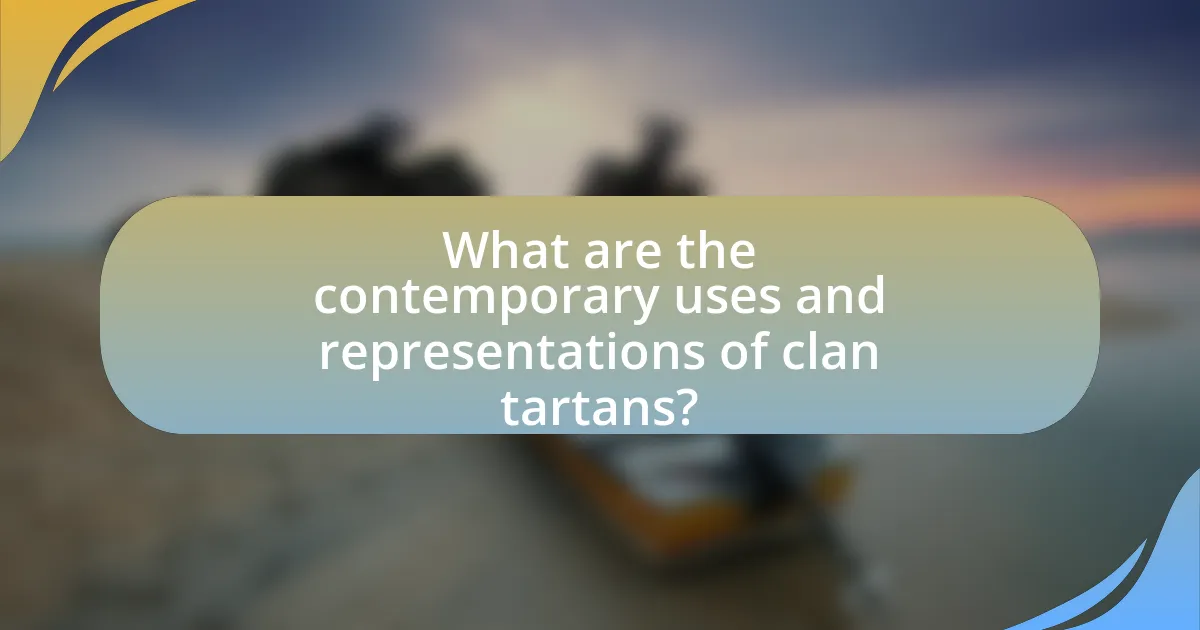
What are the contemporary uses and representations of clan tartans?
Contemporary uses and representations of clan tartans include their application in fashion, home decor, and cultural events, symbolizing Scottish heritage and identity. Clan tartans are often worn during celebrations such as weddings, Highland games, and festivals, reinforcing a sense of belonging and pride among Scots and those of Scottish descent. Additionally, tartans are utilized in various products, from clothing to accessories, reflecting both traditional and modern interpretations of Scottish culture. The Scottish Register of Tartans, established in 2008, serves as an official record, ensuring the preservation and recognition of these patterns, which are often linked to specific clans or families, thus maintaining their cultural significance.
How are clan tartans incorporated into modern fashion and design?
Clan tartans are incorporated into modern fashion and design through their use in clothing, accessories, and home decor, reflecting cultural heritage and identity. Designers often integrate tartan patterns into contemporary garments such as skirts, jackets, and scarves, appealing to both traditional and modern aesthetics. For instance, brands like Burberry have popularized tartan in luxury fashion, showcasing its versatility and timeless appeal. Additionally, tartans are frequently used in interior design, appearing in upholstery, curtains, and rugs, which reinforces their status as symbols of Scottish heritage. The resurgence of interest in heritage fashion has further solidified the role of clan tartans in modern design, as consumers seek authentic connections to their ancestry and cultural roots.
What trends are emerging in the use of tartans in contemporary clothing?
Emerging trends in the use of tartans in contemporary clothing include a shift towards sustainable fashion, increased customization, and the blending of traditional patterns with modern designs. Sustainable fashion has led brands to source eco-friendly materials for tartan garments, reflecting a growing consumer preference for environmentally responsible choices. Customization allows individuals to create unique tartan patterns that resonate with personal identity, enhancing the emotional connection to the clothing. Additionally, designers are innovating by incorporating tartan into streetwear and high-fashion collections, demonstrating its versatility and appeal across various demographics. This evolution in tartan usage not only preserves its cultural significance but also aligns with contemporary fashion movements.
How do designers honor traditional tartans while innovating new styles?
Designers honor traditional tartans by incorporating classic patterns and colors while introducing modern silhouettes and materials. This approach allows them to respect the historical significance of tartans, which are deeply tied to Scottish clan identities, while also appealing to contemporary fashion sensibilities. For instance, designers may use traditional tartan patterns in innovative ways, such as applying them to unexpected garments or accessories, thus bridging the gap between heritage and modernity. This method not only preserves the cultural essence of tartans but also revitalizes their relevance in today’s fashion landscape.
What events celebrate clan tartans and Scottish culture today?
Events that celebrate clan tartans and Scottish culture today include the Highland Games, which feature traditional Scottish sports, music, and dance, and the Edinburgh Festival, showcasing Scottish arts and heritage. Additionally, clan gatherings and festivals, such as the Clan Gathering at the Scottish Parliament, promote clan identity and heritage through various cultural activities. These events reinforce the significance of tartans in Scottish nationalism, as they serve as symbols of clan pride and cultural unity.
How do festivals and gatherings promote the significance of clan tartans?
Festivals and gatherings promote the significance of clan tartans by providing a platform for cultural expression and community bonding among individuals of Scottish heritage. These events often feature parades, competitions, and displays where participants wear their clan tartans, reinforcing a sense of identity and belonging. For instance, the Royal Edinburgh Military Tattoo showcases various clan tartans, attracting thousands of visitors and highlighting their historical importance. This visibility fosters pride in Scottish heritage and strengthens the connection to clan history, as tartans are often linked to specific clans and their legacies.
What role do clan tartans play in international Scottish events?
Clan tartans serve as a symbol of Scottish heritage and identity at international events, reinforcing cultural pride among Scots and those of Scottish descent. These distinctive patterns represent specific clans, fostering a sense of belonging and community among participants. For instance, during events like the Edinburgh Festival or Highland Games, individuals don their clan tartans to celebrate their lineage, which enhances the visibility of Scottish culture globally. The use of tartans in these contexts not only showcases traditional attire but also promotes awareness of Scotland’s rich history and the significance of clan affiliations, thereby strengthening national identity on an international stage.
What practical tips can individuals follow to honor their clan tartan?
Individuals can honor their clan tartan by wearing it in clothing and accessories, such as kilts, scarves, or ties, which visibly represent their heritage. This practice not only showcases personal identity but also fosters a sense of community among those who share the same clan. Additionally, participating in clan gatherings or events, where tartan is prominently displayed, strengthens connections to cultural traditions. Historical evidence shows that the use of tartan has been a symbol of Scottish identity since the 16th century, reinforcing its importance in contemporary expressions of nationalism.
